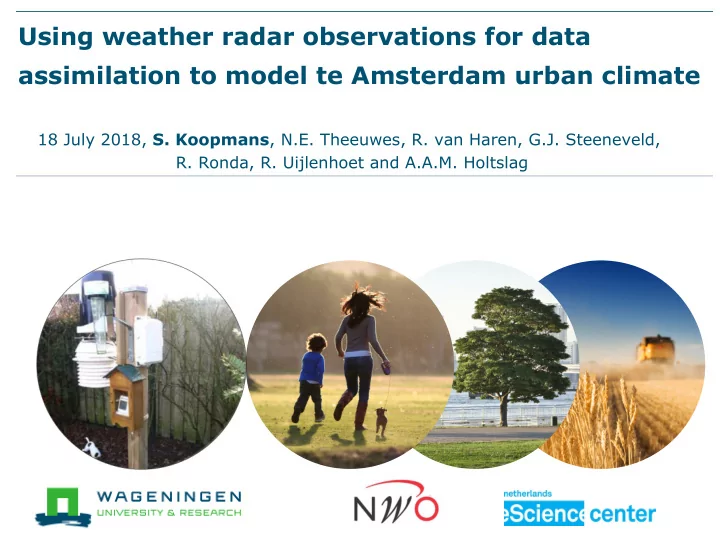

Using weather radar observations for data assimilation to model te Amsterdam urban climate 18 July 2018, S. Koopmans , N.E. Theeuwes, R. van Haren, G.J. Steeneveld, R. Ronda, R. Uijlenhoet and A.A.M. Holtslag
Motivation § Urbanization together with climate change illustrate need of understanding urban hydrometeorology. ● Occurrence of extreme precipitation ● Heat stress § Lack of long term city observations and model simulations § Aim: 15 year fine scale (100 m !) urban climatology re- analysis archive for Amsterdam (and other cities in NL)
Verification and testing: July 2014 § Case July 2014: ● 16-20 July, heat wave ● 28 July, extreme precipitation
Methodology Dimensions WRF model 4 Domains with 12500:2500:500:100 m resolutions • Use ECMWF (Reanalysis) boundaries every 6 hours, 0.5 ⁰ x 0.5 ⁰ •
Detailed urban morphology data Ronda, R.J., G.J. Steeneveld, B.G. Heusinkveld, J. Attema, B. Holtslag, 2017: Urban fine-scale forecasting reveals weather conditions with unprecedented detail, BAMS Inner domain subgrid turbulence closure: • (Smagorinsky first order closure 3D) Detailed urban morphology NUDAPT •
Other WRF model settings § 72 vertical (eta) levels § NOAH LSM § PBL scheme YSU in largest 3 domains § Grell-Devenyi cumulus scheme in outer domain § Make use of SLUCM (Single Layer Urban Canopy Model) Kusaka, 2001
Data assimilation (3DVAR) § Data-assimilation techniques of various sources of observations. • Step 1: Include WMO stations, (pressure, wind, T2m and TD) • Step 2: Include radar observations • Step 3: Include urban stations from weather hobbyists § With every step of data assimilation the analysis is updated Observations (with predefined errors) Data Assimilation Analysis (T, TD, P, radar) (WRFDA) 12 (hr) 0 12 0 Background error Run 1 model Run 2
Data assimilation cycles (3DVAR) ECMWF boundaries update SST and soil moisture every 6 hour 6 hr Update boundaries Radar and wmo stations 2 hr Data Assimilation Observations WRF Forecast (WRFDA) (T, TD, P, radar) Background error model
Radar data assimilation Use volumetric radar reflectivity and radial wind velocity from De Bilt radar Reflectivity 28 July 14 UTC Radial velocity error 28 July 14 UTC Error variance reflectivity 2 DBZ Interpolation to model resolution. (exclude lowest elevation angle 0.3 º ) Indirect data-assimilation. Assimilate rainwater mixing ratio derived from • volumetric radar data. (Wang et al, 2013)
Urban data assimilation Weather Underground About 300 stations in NL Direct transfer to wunderground website Various time intervals, instruments, siting...
Urban data assimilation Bell et al, 2015
Urban data assimilation § SLUCM does not interact with WRFDA § Single urban stations are not representative for neighborhood and city scale due to local variability
Urban data assimilation § Urban temperatures are nudged by applying correction on urban fabric (walls and roads). Urban fabric has storage to preserve the effect of nudging between 2 cycles. § 𝑫𝒑 𝑫𝒑𝒔𝒔𝒇𝒅 𝒇𝒅𝒖𝒋𝒑 𝒖𝒋𝒑𝒐 𝒑𝒈 𝒑𝒈 𝑼 𝟑 𝒏 = 𝜷 ∗ 𝑴 ↓+ 𝜸 ∗ 𝑽 + 𝜹 𝑴 ↓= 𝒆𝒑𝒙𝒐𝒙 𝒐𝒙𝒃𝒔𝒆 𝒎𝒑𝒐𝒉 𝒐𝒉𝒙𝒃𝒘𝒇 𝒔𝒃 𝒔𝒃𝒆𝒋 𝒆𝒋𝒃𝒖𝒋𝒑𝒐 𝒑𝒐 ( 𝑿 𝒏↑ 𝒏↑ −𝟑 ) Example of outer wall temperature correction in the evening. ( º C) 𝑽 = 𝒙𝒋𝒐𝒆 𝒐𝒆 𝒕𝒒 𝒕𝒒𝒇𝒇𝒆 (𝒏𝒕↑ 𝒕↑ −𝟐 ) § Correction T2m is divided over wall and road layers. Division scaled to amplitude material. Large amplitude-> larger adjustment.
Results Urban results • No data assimilation shows cold bias WRF for cities WMO+radar RMSE = 2.07 º C NL domain Bias = -1.36 º C WMO+radar+urban: RMSE= 1.69 º C Bias= -0.71 º C
Urban results Amsterdam domain WMO+radar RMSE = 1.86 º C Bias = -0.84 º C WMO+radar+urban: RMSE= 1.25 º C Bias= -0.18 º C
Case 28 July 2014 Results Weak flow in atmosphere with a convergence zone over the • Netherlands
Case 28 July 2014 Radar + urban Observations WMO Noda (no data Assimilation)
Wind 28 July 2014 Radar + urban Noda WMO
Fractional skill score Radar + urban MSE = 0.11 Obs Error variance WMO MSE= 0.23 𝐺𝑇𝑇 =1− 𝑁𝑇𝐹/𝑁𝑇𝐹↓𝑠𝑓𝑔 Error variance Error variance 𝑁𝑇𝐹 = 1 /𝑂↓𝑦 𝑂↓𝑧 ∑𝑗 =1 ↑𝑂↓𝑦 ▒∑𝑘 =1 ↑𝑂↓𝑧 ▒[𝑃↓𝑗 , 𝑘 − 𝑁↓𝑗 , 𝑘 ]↑ 2 Roberts and Lean, 2008
General verification Precipitation - Verification on subset of wmo stations 1 and 2 hour after data assimilation
Conclusions § WMO data assimilation improves forecast substantially in various meteorological metrics. § Radar data assimilation is challenging, addition slightly/moderately better in predicting location precipitation § Nudging the urban temperatures with citizen weather stations reduces the cold biases present in WRF
Recommend
More recommend